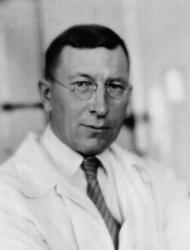Sir Frederick Grant Banting, (November 14, 1891 – February 21, 1941) was a Canadian medical scientist, doctor, painter and Nobel laureate noted as the first person that used insulin on humans.
In 1923 Banting and John James Rickard Macleod received the Nobel Prize in Medicine. Banting shared the award money with his colleague, Dr. Charles Best. As of September 2011, Banting, who received the Nobel Prize at age 32, remains the youngest Nobel laureate in the area of Physiology/Medicine. The Canadian government gave him a lifetime annuity to work on his research. In 1934 he was knighted by King George V. In 2004, Frederick Banting was voted fourth place on The Greatest Canadian.
Scientific studies
An article he read about the pancreas piqued Banting's interest in diabetes. Research by Naunyn, Minkowski, Opie, Schafer, and others suggested that diabetes resulted from a lack of a protein hormone secreted by the islets of Langerhans in the pancreas. Schafer had named this hormone insulin. Insulin was thought to control the metabolism of sugar; its lack led to an increase of sugar in the blood which was then excreted in urine. Attempts to extract insulin from ground-up pancreas cells were unsuccessful, likely because of the destruction of the insulin by the proteolysis enzyme of the pancreas. The challenge was to find a way to extract insulin from the pancreas prior to its being destroyed.
Moses Barron published an article in 1920 which described experimental closure of the pancreatic duct by ligature which further influenced Banting's thinking. The procedure caused deterioration of the cells of the pancreas that secrete trypsin but left the islets of Langerhans intact. Banting realized that this procedure would destroy the trypsin-secreting cells but not the insulin. Once the trypsin-secreting cells had died, insulin could be extracted from the islets of Langerhans. Banting discussed this approach with J. J. R. Macleod, Professor of Physiology at the University of Toronto. Macleod provided experimental facilities and the assistance of one of his students, Dr. Charles Best. Banting and Best began the production of insulin by this means.
Banting was appointed Senior Demonstrator in Medicine at the University of Toronto in 1922. The following year he was elected to the new Banting and Best Chair of Medical Research, endowed by the Legislature of the Province of Ontario. He also served as Honorary Consulting Physician to the Toronto General, the Hospital for Sick Children, and the Toronto Western Hospital. At the Banting and Best Institute, he researched silicosis, cancer, and the mechanisms of drowning. During the Second World War he investigated the problems of aviators, such as "blackout" (syncope).
Awards and honours
Prior to the award of the Nobel Prize in Physiology or Medicine for 1923—which he shared with Macleod—he received the Reeve Prize of the University of Toronto (1922). In 1923, the Canadian Parliament granted him a Life Annuity of $7,500. In 1928 Banting gave the Cameron Lecture in Edinburgh. He was a member of numerous medical academies and societies in Canada and abroad, including the British and American Physiological Societies, and the American Pharmacological Society. In 1934 he was knighted as a Knight Commander of the Order of the British Empire (KBE) and became an active Vice-President of the Diabetic Association (now Diabetes UK). In May, 1935 he was elected a Fellow of the Royal Society.

